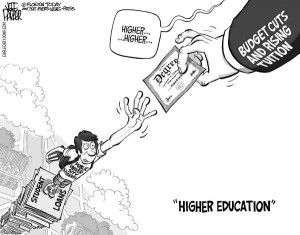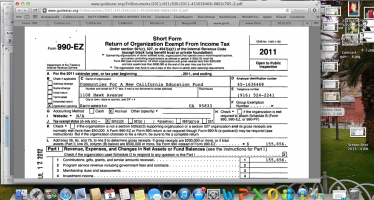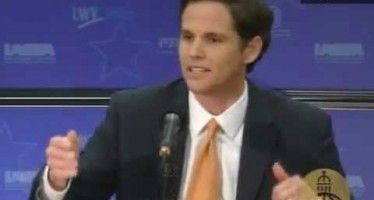Tax hike won’t solve Cal State’s budget problems
By John Hrabe
Congratulations or condolences?
It’s hard to say which is more appropriate for Timothy P. White, the newly appointed Chancellor of the California State University system. White takes over the top job at the country’s largest and perhaps most beleaguered public university system. Over recent years, Cal State has been fraught with controversies involving its executive compensation policies, state budget cuts and an endless series of tuition hikes.
In the press announcement of White’s hiring, CSU Board Chair Bob Linscheid said, “Tim White’s background and experience reflect the institutional values and mission of the CSU.” Institutional values? Linscheid should have just called the new chancellor a company man, who will do whatever it takes to protect and preserve the Cal State institution.
Now — more than ever — Cal State needs someone who isn’t a bureaucratic insider. The unimaginative educrats in the Cal State Chancellor’s office only see two options: increase revenue or cut spending. Since Cal State administrators aren’t about to give up their lucrative benefits, they’ve engaged in an unabashed and illegal campaign for Gov. Jerry Brown’s multi-billion dollar tax increase, Proposition 30.
“With slightly more than one month remaining until the November election, CSU campuses are hosting a variety of informational events detailing the impact of Proposition 30 on campuses and the university system as well as voter registration drives,” Cal State explained in a recent government-sponsored press release. “The 2012-13 California state budget includes a mid-year ‘trigger’ cut tied to Proposition 30 and if the measure is not approved by voters, the CSU budget will be cut by $250 million.”
The Howard Jarvis Taxpayers Association has fought back against Cal State’s blatant campaigning. HJTA president Jon Coupal told ABC News last month, “When they specifically reference Prop. 30 and the revenue that it would provide, then they’ve crossed the line.”
Coupal is right, but that doesn’t mean anyone should be surprised by Cal State’s actions. Cal State and its new chancellor are stuck in the old structure. In response to 2009 budget cuts, White told the Inland Valley Daily Bulletin, “The Regents action to raise fees was the ‘least lousy’ alternative in front of UC. Because the state is providing insufficient funding for UC, raising fees was the only choice left to help maintain the high quality programs Californians deserve and expect.”
Two years later, White’s response hadn’t changed much. “You’re not only cutting access. You’re also cutting out the seed corn of tomorrow’s innovations,” he told the San Bernardino County Sun as a part of an education summit to “drum up support for a special election and an extension of current tax rates.”
Earlier this year, then-UC Riverside Chancellor White told the New York Times, “I’d be lying if I said what we offer students hasn’t been changed and that there hasn’t been a degradation of the learning environment.”
Structural deficit
Even if Prop. 30 passes, it’s a temporary fix for Cal State. That’s because Cal State’s structural budget can’t cope with incremental institutional cost increases. Pensions, health care and energy costs are all up at Cal State. Meanwhile, state support of higher education, like every other budget item, is down.
To underscore this point, CalWatchDog.com has reviewed more than three decades of budget, enrollment and tuition data to evaluate the biggest claims in higher education. Cal State administrators say that state support of higher education is down. Taxpayer groups point to extravagant executive compensation for top administrators. Faculty members claim that their pay and benefits are static. Students complain that their tuition bills have skyrocketed. Parents argue that their tax dollars are funding more foreign and out-of-state students to boost revenue.
Who’s right? Everyone. And that’s exactly the problem. The institution is broken.
State Legislators Have Approved Record Budget Cuts to Cal State
In the past decade, there has been a fundamental shift in how taxpayers and students split the bill for a Cal State education. In 2000-01, the state spent more than $2.47 billion in general fund expenditures on the Cal State system, while student fees accounted for $482 million dollars of the overall budget. In 2012, the state’s general fund contribution fell to $2.01 billion, and student fees have risen to $1.593 billion— a 230 percent increase in a little more than a decade.
In 1999-2000, the average full-time equivalent Cal State student paid just 20.3 percent of the cost of his education. Nearly three-quarters of the bill was paid by state taxpayers, with the remaining 5.6 percent picked up by other sources. In 2010-11, the average full-time equivalent Cal State student paid 37 percent of his total education costs. The state’s portion fell to 55 percent.
According to a January 2012 report by the state’s independent Legislative Analyst’s Office, “recent tuition increases and state funding cuts” could raise the Cal State students’ share to 46 percent. However, the LAO also points out, “Because they do not account for facilities costs, these figures actually over-state the share students pay. Facilities costs, which are difficult to calculate, can add roughly 20 percent to the annual cost of education.”
Who should pay what? There’s plenty of room to debate how the bill should be split. But, it’s clear that the financial burden has changed dramatically in the past decade.
Cal State Tuition Has Skyrocketed
Following with the shift in overall state budget funding, tuition has skyrocketed for Cal State students. In less than eight years, tuition has risen 150 percent, from $2,334 per year in 2004 to just under $6,000 this fall. In just the past two years, the cost of attendance for a Cal State student living off campus has increased by $2,602 — from $23,712 to $26,314. Tuition represents 83 percent of these increased education costs.
According to the LAO, not all students pay these higher tuition bills. “Nearly half of all undergraduates at California’s public colleges and universities receive grants or waivers that fully cover education fees,” the LAO explained in a report titled, “Higher Education: Answers to Frequently Asked Questions.”
Don’t forget that student tuition and fees are tax-deductible thanks to the American Opportunity Tax Credit, which is worth up to $2,500 per year in federal tax credits per student. Again, the LAO says that tax credit helps “39 percent of CSU families (who) received about $270 million from this credit in 2009, averaging close to $2,000 per student.”
| Cost of Attendance | 2010-11 | 2012-13 | Change |
% |
| Total Fees | $ 5,508.00 | $ 7,660.00 | $ 2,152.00 |
39.1% |
| Books and Supplies | $ 1,704.00 | $ 1,754.00 | $ 50.00 |
2.9% |
| Food and Housing | $ 12,414.00 | $ 12,402.00 | $ (12.00) |
-0.1% |
| Transportation | $ 1,188.00 | $ 1,444.00 | $ 256.00 |
21.5% |
| Personal | $ 2,898.00 | $ 3,054.00 | $ 156.00 |
5.4% |
| Total Budget | $ 23,712.00 | $ 26,314.00 | $ 2,602.00 |
11.0% |
Cal State President and Top Administrators Have Enjoyed Lavish Perks and High Salaries
CalWatchDog.com has provided extensive coverage of Cal State’s excessive presidential pay and benefits. The average base salary of the state’s 23 college presidents is just under $300,000 per year, a figure that does not include other widely reported benefits such as a car allowance, bonuses paid by tax-exempt college foundations and free housing. Cal State presidents receive perks and benefits worth as much as 50 percent of their base salaries, or more than $145,000 per year.
According to an analysis of payroll data by the California Faculty Association, Cal State presidents awarded 486 pay raises to top managers from 2008-10. Cal State Chancellor Charles Reed handed out another 80 pay raises to his chosen bureaucratic elite. Those figures excluded promotions for staff that have internally changed positions. “On an annualized basis, these discretionary raises added $6.5 million to the cost to run the CSU system,” the study concluded.
Foreign and Out-of-State Students Fill More Slots at Cal State Universities
In 1975, Cal State admitted 391 foreign students and 1,698 out-of-state residents. Combined, foreign and out-of-state students made up less than 1 percent of the entire student body. Last year, Cal State accepted 11,489 foreign students and 4,053 out-of-state residents, which combined to account for 3.6 percent of the student body.
The increase in the number of foreign students — from 391 to 11,489 — is a bit of a statistical exaggeration. In the early 1980s, foreign students represented roughly 3 percent of the student body, peaking in 1981 with 10,231 foreign students.
Regardless of which year you pick as the starting point, it is true that foreign and out-of-state residents account for a bigger portion of the student body. Since 1975, the average combined percentage of foreign and out-of-state students has been 2.94 percent. In 2011, these groups accounted for 3.6 percent of the student body.
| Out of State |
Foreign |
Combined Rate |
|
| Average Since 1975 |
0.66% |
2.28% |
2.94% |
| 1980s Average |
0.6% |
2.7% |
3.3% |
| 1990s Average |
0.5% |
2.2% |
2.6% |
| 2000s Average |
0.8% |
2.3% |
3.1% |
| 2011 |
1.0% |
2.69% |
3.6% |
Increased Institutional Costs: Faculty Health Premiums Have Increased
The California Faculty Association, which represents 23,000 employees on the 23 campuses, recently ratified a new contract agreement. Employees didn’t receive pay raises, but they did preserve their health benefits. Many state agencies pay 80 percent of employee health plan premium costs. Cal State is a bit more generous and pays 95 percent of the bill.
Health care isn’t getting any cheaper. In 2011-12, Cal State spent an additional $36.4 million in health care premium increases. According to the Cal State budget analysis, “The total increase in CSU health care costs due to contribution changes during this five-year period is nearly $104.4 million.” And that money was to maintain the status quo. Employees didn’t get better health coverage or see their premiums decrease. Over the last five years, it’s cost more than $100 million more to keep things exactly as they are.
Related Articles
Admin costs crowd out teaching
JULY 26, 2010 By JOHN SEILER A revealing new study shows that in recent years increases in the administrative costs
Do union activists work for Gov. Brown, farm board?
SACRAMENTO — The revolving door among political consultants, community organizers and state government revolves right into the governor’s office and the Agriculture
Language of teacher discipline bill shows Torlakson’s deceit
At a little bit after the 51-minute mark of a forum in Los Angeles last week with state Superintendent of





